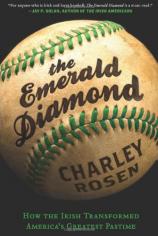The Emerald Diamond: How the Irish Transformed America's Greatest Pastime
Review
The Emerald Diamond: How the Irish Transformed America's Greatest Pastime
Just in time for St. Patrick’s Day, Charley Rosen offers a tip of the tam o’ shanter to the many men who helped shape the national pastime into the game we enjoy today in this fast-paced history.
Rosen --- whose previous baseball book (following more than a dozen fiction and nonfiction titles about basketball) was 2011’s BULLPEN DIARIES: Mariano Rivera, Bronx Dreams, Pinstripe Legends, and the Future of the New York Yankees--- goes back to the game’s roots to report how so many sons of Erin influenced the style, rules and governance of baseball. Some late 18th-century practitioners, such as Michael “King” Kelly, were lauded in song and story for their exploits on the field. Others, like John Montgomery Ward, were instrumental in seeking rights for players in an era when owners held all the cards and managed their “property” with an iron hand. Additional high-profile figures include the five Delahanty brothers, one of whom met an ignominious end when he plunged to his death from a bridge after being put off a train for drunken behavior.
"Just in time for St. Patrick’s Day, Charley Rosen offers a tip of the tam o’ shanter to the many men who helped shape the national pastime into the game we enjoy today in this fast-paced history."
From these humble beginnings came future Hall of Fame managers Connie Mack (born Cornelius Alexander McGillicuddy) and John “Mugsy” McGraw. Between them they managed the Philadelphia Athletics and New York Giants, respectively, for a combined 81 years.
The main influence of the Irish took place over the first half-century of baseball as a professional enterprise. They brought with them a love of the physical and a certain rowdy attitude that was not appreciated by those who wanted to maintain baseball as an activity for middle and upper-class gentlemen. Rosen reports on a time in this nation when advertisements for jobs and housing came with the caveat “No Irish Need Apply”; anti-Irish sentiment was high in the mid-1800s, as thousands came over the Atlantic in the wake of the Potato Famine.
The book is divided into four eras: “Humble Beginnings” (roughly 1869, when the first professional club took the field), “The Emerald Age” (1882-1899), “A New Century” (1900-1949), and “Postwar to Present.” Rosen highlights a player or an event of innovation in each chapter, which generally covers a year or two, and rounds out with dozens of interesting and educational factoids, such as league leaders and record holders. He includes brief interviews with a handful of current players, most of whom have at least some sense of their proud heritage.
Not all contributions were made on the field as Rosen reports. Two prime pieces of baseball Americana --- the game’s “anthem” “Take Me Out to the Ball Game” and the classic poem “Casey at the Bat” --- feature Irish fans and players as the main characters. He concludes THE EMERALD DIAMOND with a nod to Foley’s Pub and Restaurant in Manhattan, the “official” Irish-American Baseball Hall of Fame, a fun establishment that should be on every fan’s list of baseball attractions to visit.
Reviewed by Ron Kaplan on March 15, 2012
The Emerald Diamond: How the Irish Transformed America's Greatest Pastime
- Publication Date: February 28, 2012
- Genres: History, Nonfiction, Sports
- Hardcover: 320 pages
- Publisher: Harper
- ISBN-10: 0062089889
- ISBN-13: 9780062089885





